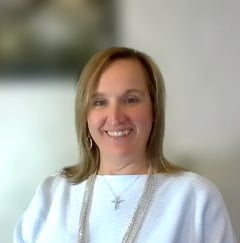Ever heard the phrase "reaching across the aisle" or "working across the aisle" and wondered where that came from? Maybe you’re familiar with the setup of the United States Senate - the seating is set up in a semi-circle, with Republicans on one side of the room and Democrats on the opposite side. Between the two groups is a large aisle. Much of their time is spent debating issues, sometimes pointing fingers at who’s right and who’s wrong on either side of the aisle. When individuals collaborate together, across party lines, it's called "reaching across the aisle." When we reach across the aisles, we work to close a divide. We work together with people we don’t always agree with. This, my friends, is a skill we all could stand to improve.
I’ve recently encountered more than a handful of conversations with people who seem, at first glance, to be convinced that they are right.
As recently as this week, I heard people refer to those of a different political persuasion as their "enemies," and I heard individuals indicate that those who shared their set of perspectives on a given topic had the only possible claim to truth. Since they were talking about a perspective that I don't share, but a Faith foundation that I do, I was caught off guard by their passionate assertion of being right.
Being right, being confident that we’re right, is a good thing, especially if we’re doing something important, or something that we’re passionate about.
But when being “right” means that everyone else is “wrong” and somehow “less-than”, there’s a problem.
Working relationships get strained to the point where they’re not relationships, and they simply don’t work.
So, what do we do about it? We improve our listening skills, our questioning skills, our self-awareness skills, and our other-awareness skills.
1. Let’s start with listening.
Usually, when we go into a conversation assuming we’re right, we get so busy talking, we’re using our mouth and not our ears. Remember that old adage – “God gave us two ears and only one mouth”? Let’s use them in that ratio. If there’s even the slightest chance that I find myself thinking I’m right, I’m going to close my mouth, open my ears, and listen.
Here are some ideas on how to start with listening:
Listen for places we agree.
It’s easy to jump ahead of ourselves and begin defending our opinions. It’s harder to slow down and find the things we can agree on. But when we do, we build common ground. From there we have greater opportunities to further our relationships. We establish a baseline for future conversations. We say, “I want to meet you somewhere we can agree, because I care about this relationship”.
Listen for things they see that I don’t see.
We’re aware that we are different than the people around us. We look, sound, and talk differently, but we also live and believe differently. When we recognize these differences, we recognize that people have perspectives that are different than our own. I cannot see things from my 5'4" frame that someone else can see from their 6'2" frame. I can ask a question like, "tell me what you can see from where you stand?" to start the conversation.
Listen for things they’ve experienced that I haven’t experienced.
Recognize that the walk in their shoes is not the same as my journey in my shoes. No two people have the same lived experiences. Those experiences shape who we are, what we do, and how we think. We can’t separate those experiences from the person, but we can learn from them. In the same way, others can learn from our lived experiences. This exchange happens when we provide spaces for people to share. I can invite someone to share their story, and I can close my mouth and listen while they tell it.
Listen for things I can value and appreciate about them.
Because they are human first, they have value and worth, even if we don’t see eye-to-eye. If we only surround ourselves with people who think like us, we miss out on building beautiful human connections with cool and interesting people. We miss out on opportunities to learn and grow. We miss chances to appreciate the creativity, uniqueness, and talent all around us. So, it’s up to us to find things we admire and appreciate about the other person, and to let them know!
By listening and not talking, we can encourage others to share more about what they think, how they feel, and how they came to believe what they believe.
2. How about questioning?
Once I’ve stayed quiet long enough to really listen, I can ask some good follow-up questions that help me demonstrate that I was listening. These aren’t questions that inflame or judge, but questions that demonstrate curiosity and show I care. Questions are how we learn even more and express our excitement at opportunities for understanding.
Here are some powerful question prompts:
- What would be a good outcome for you?
- What changes would you like to see?
- What have you observed that has worked before?
3. Then on to self-awareness.
If I think I’m right, it’s probably healthy to pause and reflect on why I think that. Paying attention to why I think I’m right can help me be, well, less wrong.
Here are some questions of self-reflection:
- What lens causes me to think I’ve got the right answers here, and where could my blind spots be?
- When I’ve been in a similar spot before, what did I miss?
- When I’ve been surprised before, what surprised me and how does that relate here?
- When I’ve learned things in the past, how did I learn them, and how does that relate here?
- When those who know me best describe me, how do they usually describe me, and how does that play into my perspective here?
When we practice self-awareness, we grow in our emotional intelligence, and learn how to balance and control our emotions. When we’re self-aware of both what we do well, and what we don’t do quite as well, we become better at taking a step back and thinking critically about how both of us could be right and wrong.
4. Now for other-awareness.
If I’ve done all this well, I can put myself aside and really reflect on this other person as a valuable, contributing member of society. They have a voice, they have a right to contribute to the conversation just as much as I do, and it’s up to me to make sure that I’m not doing anything to silence them, close them down, devalue them, belittle them, or make them feel less-than.
Here are some prompts to help:
- What do they excel at?
- What is their frame of reference for this conversation?
- What lens do they look through?
- How can I learn from their worldview?
All of these together can help us see that maybe there isn’t just one right. Maybe we can be both right, and it's even possible we’re all a little wrong. Let me give an example...
Years ago, around the holidays, my family was playing a game of “I spy with my little eye”. We went around the room looking for the “something orange” one of the uncles had suggested, but it was Christmas time and there was every color except for orange.
Finally, one of the little kids climbed in his lap and scooted way up until her eyes were even with where his eyes were. She looked around the room, and with a great squeal of delight she ran over to the television and pointed at the sticker on it, saying “Is this it?” “Is this it?”
“Yes!” He said, that was it!
Now the thing is, from where I sat, that sticker looked blue; from where my husband sat it looked purple; but where the uncle sat it looked orange. So, it turns out we were all right.
But, in truth, it was a reflective sticker that caught the light just right, and when you got up close to it, it was actually silver. So really, we were all a little bit wrong. None of us had the right answer. We each had a perspective on what we saw, until we stopped and really took the time to investigate.
The lesson, so powerfully demonstrated by the youngest generation present, was that sometimes you have to be willing to see things from someone else’s perspective. From his perspective, he was right – it did look orange. And for the rest of us to see the orange, we just had to see it from where he sat.
To build authentic human connections, we have to be willing to acknowledge that on this journey of life we’re on, and we might not all be all right, all the time. We might just need to see things from each other’s point of view from time to time to help us get along. That starts with being willing to get out of our own way, to listen well, to ask good questions, and to welcome the other person's perspective. Perhaps better equipped with these skills we can spend more time working across the aisles.
Want more about authentic human connection? It happens to be one of the core tenets of our Changemakers Certification Program. Check out our resource page if you’re interested in more information!








